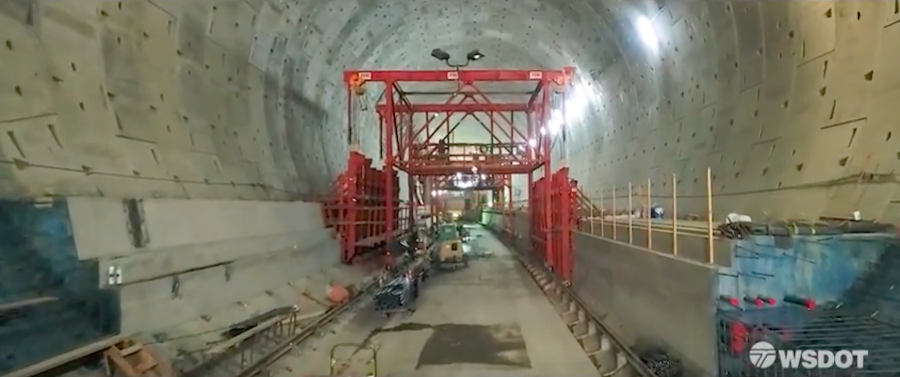Bertha made the tunnel, but now Seattle Tunnel Partners crews working on behalf of the Washington State Dept. of Transportation must turn that tunnel into a workable 1.7-mile double-decker roadway.
WSDOT released a fly-through video of the tunnel, shot with a drone in late September, to bring you through the tunnel’s north end, near the Space Needle, all the way out the south end, near the Seattle stadiums. The two-minute video shows off about two miles of ongoing construction work that will replace the aging Alaskan Way Viaduct near Seattle’s waterfront.
As the drone moves south, you see more completed tunnel, as work moves from the south to the north, the same direction that Bertha bored the tunnel. The corbels—foundations of the road and walls—are now 100 percent complete, while the top deck of the double-deck roadway, which will carry southbound traffic, is 85 percent complete. The walls for the southbound roadway are still a work in progress and the northbound walls are 94 percent complete. Work hasn’t yet started on the northbound roadway, the bottom section of the double-decker structure and the final major piece to tunnel construction.
Moving through the video, viewers can check out everything from the location of the roadway decks to how the new lighting systems and ventilation corridors all work inside the tunnel. Near the end, the drone pops out of the bored tunnel and shows off the connection to Seattle and the location of the tunnel and operations building in relation to the current landscape.
Tunnel mining concluded in April 2017, but work has been ongoing inside the tunnel long before that as crews followed the tunnel-boring machine with construction projects. The first step involved building lower interior walls atop corbels. Then crews moved to build the upper roadway on top of the lower interior walls. Steps also include building upper interior walls on the top of the upper roadway.
Work will continue uninterrupted on the 9,270-ft tunnel as the latest plans have it opening to traffic in early 2019.
Follow Tim Newcomb on Twitter at @tdnewcomb.


Post a comment to this article
Report Abusive Comment